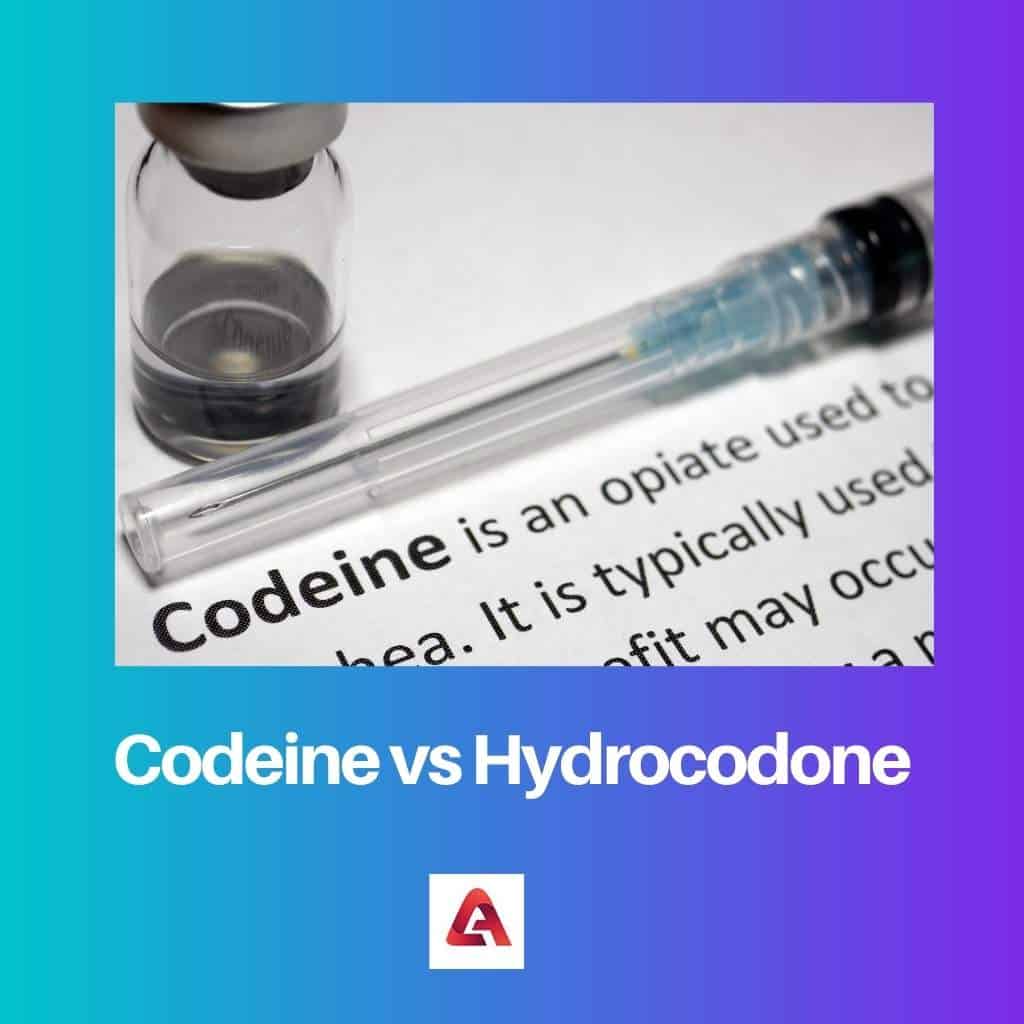Mild pain may not require treatment, and most people seek relief from moderate to severe or persistent pain. If natural or over-the-counter pain relievers don’t work, talk to your doctor about prescription pain relievers.
Although codeine and hydrocodone are prescription pain relievers, these narcotic drugs are easily abused.
Key Takeaways
- Codeine and hydrocodone are opioid analgesics used to treat moderate to severe pain.
- Codeine is less potent than hydrocodone, making it suitable for less severe pain cases.
- Hydrocodone is commonly combined with other medications like acetaminophen to enhance its effectiveness.
Codeine vs Hydrocodone
Codeine is a Schedule II drug, while Hydrocodone is a Schedule III drug. Codeine is stronger than hydrocodone and is also more dangerous of the two. Hydrocodone has a more sedative effect than codeine and is more effective for severe pain. It also has more of an abuse potential than codeine.

Codeine is a minor pain reliever and cough suppressant. Because codeine is a low-strength substance on its own, combining it with another substance, like acetaminophen, helps to boost its potency.
It’s a natural offshoot of the opium plant. Because codeine is more readily available than other opioids, it’s a common ingredient in cough syrups.
Because it’s so easy for teenagers to get their hands on cough medicine, you might have a bottle or two in your bathroom cabinet right now. They’re more likely to misuse it than adults.
Unlike codeine, hydrocodone is an opioid analgesic used to treat mild to fairly severe pain. In this regard, hydrocodone is more effective than codeine.
On the other hand, hydrocodone is a close relative of codeine, which is processed in the liver and then eliminated by the kidneys. It contains the major metabolite of hydromorphone and the minor metabolite of dihydrocodeine.
In pharmaceutical preparations, hydrocodone is used in combination with acetaminophen.
Comparison Table
| Parameters of Comparison | Codeine | Hydrocodone |
|---|---|---|
| Prescribed for | Mild to moderate pain. | Moderate to severe pain. |
| Drug Class | Natural opioid. | Semi-synthetic opioid. |
| Uses | Pain, Cough. | Pain. |
| Dosage | It depends on the situation; a typical dosage is 15 to 30 mg every 4 hours as required. | The dosage varies; a typical amount is 10 mg every 12 hours. |
| Warnings | Addiction, overdose, and drug interactions with central nervous system depressants are all included in the FDA Black Box Warning. | There is an FDA Black Box Caution for addiction, overdose, and drug interactions with central nervous system depressants, as well as a warning against consuming alcohol while taking the long-acting version of the medication. |
What is Codeine?
Codeine is an opioid drug that is found in nature and is used to treat mild to severe pain.
This medicine is offered as a single tablet, as a pill with acetaminophen (Tylenol with Codeine), or in a liquid version with promethazine, guaifenesin, or aspirin.
Codeine attaches to opioid receptors and decreases pain signals when taken for pain.
Codeine reduces activity in the regions of the brain that cause coughing when administered to treat coughing.
Despite the fact that this medicine is much less potent than other opioids, it nevertheless poses a risk of misuse, addiction, and physical dependency. When codeine is eaten, the brain converts it to morphine.
Therefore it acts similarly to morphine and heroin.
Codeine is a Schedule II-restricted drug, according to the DEA.
Codeine Side Effects include Headache, Stomach discomfort or nausea, Difficulty urinating, and Constipation. Other more significant codeine side effects include Irritation or hallucinations, Sexual impotence, Irregular heartbeat, Rash, itching, and hives, Shallow breathing, vision changes, and seizures.
What is Hydrocodone?
Hydrocodone is a semi-synthetic opioid drug that is used to treat moderate to severe pain. It is only prescribed for people who need around-the-clock pain relief or who are unable to use other pain relievers.
In people who are allergic to codeine, it is also better tolerated.
Hydrocodone is most frequently used in combination with acetaminophen and is available as a pill (Vicodin or Lortab), although it may also be used as a cough suppressant.
Hydrocodone attaches to opioid receptors and slows down the central nervous system in the same manner as other opioids do. It’s a powerful opioid with a high potential for abuse, addiction, and overdose.
The DEA has classified hydrocodone as a Schedule III controlled substance, indicating that it has a higher potential for abuse than drugs like codeine.
Hydrocodone Side Effects Common hydrocodone side effects include Stomach pain or cramping, Dry mouth, Fatigue, Headache, Tight muscles, Difficult or frequent urination Difficulty staying asleep.

Main Differences Between Codeine and Hydrocodone
- Codeine is prescribed for mild to moderate pain, whereas Hydrocodone is prescribed for moderate to severe pain.
- Codeine is a natural opioid, whereas Hydrocodone is a semi-synthetic opioid.
- Codeine is used for pain and cough, whereas Hydrocodone is used for only pain
- The dosage of codeine depends on the situation; a typical dosage is 15 to 30 mg every 4 hours as required, whereas the dosage of hydrocodone varies; a typical amount is 10 mg every 12 hours.
- Warning for codeine is addiction, overdose, and drug interactions with central nervous system depressants are all included in the FDA Black Box warning, whereas in Hydrocodone, there is an FDA Black Box Caution for addiction, overdose, and drug interactions with central nervous system depressants, as well as a warning against consuming alcohol while taking the long-acting version of the medication.




